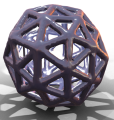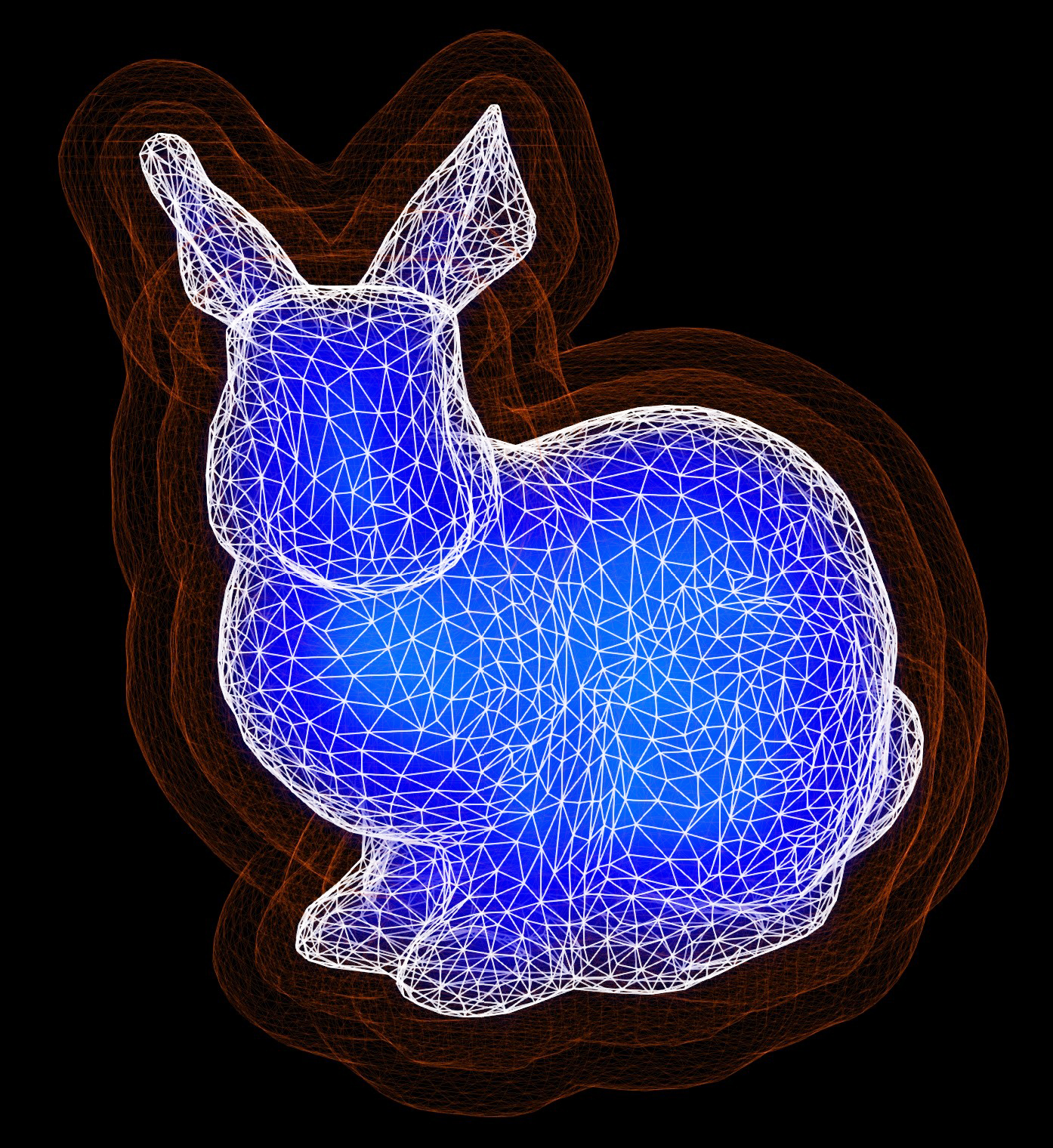
Flood filling the sign of a 2D distance field with resolution 573×502 
Flood filling the sign of a 3D distance field with resolution 38 x 38 x 34
Recall that even the pioneering old-school MS Paint provided its users with the famous paint bucket (fill) tool ![]() . Virtually all 2D graphics software has some variant of this tool. Given a raster image, we can fill any region with our desired color using a recursive procedure starting from the clicked pixel (seed) and checking each pixel’s neighbors whether they have the same original color as the starting pixel. All pixels with the same color as the seed pixel get re-colored to the fill color.
. Virtually all 2D graphics software has some variant of this tool. Given a raster image, we can fill any region with our desired color using a recursive procedure starting from the clicked pixel (seed) and checking each pixel’s neighbors whether they have the same original color as the starting pixel. All pixels with the same color as the seed pixel get re-colored to the fill color.
Distance fields can be modified by a sign factor which detects whether the sampled point is in the interior/exterior of the contour set (source)
:

This gives rise to the signed distance function defined as: . The importance of the sign factor lies, for example, in being able to render level contours (via the Marching Cubes algorithm) without rendering the interior contour which is generally invisible from outside.
Computing the sign of a distance field also removes the -discontinuity (discontinuous first and the following derivatives) from
. The gradient vector field
thus has continuous flow across the outline.
Continuum vs. Discrete Approach
Given a 2D curve , the Jordan curve theorem states that as long as
forms a simple closed loop (i.e.: closed with no self-intersections) it partitions the entire space
where it resides into the interior
, and exterior
, in other words:
The same holds for surfaces forming “blobs” topologically equivalent (homeomorphic) to
-spheres. The theorem can be proven even for infinitely complex fractal shapes.

However, when we allow self-intersections and/or holes in the outline shape the theorem no longer holds for shapes without additional information. It is generally the case that 3D meshes have imperfections (holes, non-manifold edges/vertices, self-intersections), so we cannot fully discard the possibility of categorizing points in space as internal/external even against these obstacles.

A technique introduced by A. Baerentzen and H. Aanaes (DTU Copenhagen) relies on computing angle-weighted pseudonormals for each mesh vertex
, and then computing the sign for point
as
for the closest mesh vertex. Clearly, when the dot product of the distance vector
with the normal is positive, the point lies “outside of the surface”, given proper orientation of
.
The technique relies on a property of surfaces (as manifolds) called orientability . Without elaborating too much on the general definition, orientability can be thought of as the possibility to define a continuous non-vanishing flow (vector field), the consequence of which is that a normal vector can be extended into the ambient space at each point. The math enthusiasts among the readers, surely heard about the Möbius strip or a Klein bottle as “shapes which only have a single side”. Although they are generally not used in most graphics applications, meshes with non-orientable manifold structure might be problematic in the sign computation even using the angle-weighted pseudonormal approach.
Although the angle-weighted pseudonormal technique extends the reach of signed distance fields to a wider variety of shapes, it presented a performance obstacle which I wanted to avoid all along. Given the previous post outlining a fast method for computing an unsigned distance field, it would make no sense to slow the computation down by processing all grid points one more time and perhaps utilizing the AABB tree for finding the closest mesh vertex. Readers who prefer this approach, however, might want to avoid constructing Octree for voxel outline and implementing the Fast Sweeping algorithm, and instead just use the AABB tree for the closest point lookup and run through the entire grid.
Due to reasons mentioned above I chose a discrete approach over a continuous one. My implementation uses the fact that the voxel outline (of sufficient resolution) encloses the (approximated) interior, and the sign function is undefined for meshes with holes.

Flood Fill Algorithm
Recall that during writing the voxel outline of the triangle mesh, we froze the outline voxels. Now even though the values of the distance function vary at each grid point, given a triangle mesh without holes the outline of frozen cells forms a closed boundary. In fact, a buffer with the same dimension as the grid values, containing binary values (0 or 1 – unfrozen, frozen), is stored. This means that we have a 3D equivalent of an image with just two colors. We can take our paint bucket tool and color all pixels/voxels inside the outline with any color we want.
As we update the frozenCells field, the distGrid field needs to be updated as well. We start by negating the entire distance grid (NegateData), i.e.: all distance values are now negative (as should be in ) now we find the first unfrozen cell and use it as our seed cell. The recursive flood starts from the seed cell and propagates through the entire grid. Every time it processes a pixel/voxel, it marks it as frozen and every time it encounters a cell that is already frozen, it ignores it.
The preferred data structure for this is LIFO stack (in C++ std::stack) where we store pairs (or triples) of grid indices . The stack is empty after the last available cell is processed, and none of the interior cells are ever available, because they are enclosed by the frozen outline voxels/pixels:
void ComputeSignFloodFill2D(double* distGrid, bool* frozenCells, ImageParams* imgPar)
{
NegateData(distGrid, imgPar);
double val; int gridPos;
const int row = imgPar->row;
const int nx = imgPar->width - 1;
const int ny = imgPar->height - 1;
int ix = 0, iy = 0;
std::stack<std::tuple<int, int>> stack = {};
std::tuple<int, int> idsPair;
// find the first unfrozen cell
gridPos = 0;
while (frozenCells[gridPos]) {
ix += (ix < nx ? 1 : 0);
iy += (iy < ny ? 1 : 0);
gridPos = row * iy + ix;
}
stack.push({ ix, iy });
// a simple pixel flood
while (stack.size()) {
idsPair = stack.top();
stack.pop();
ix = std::get<0>(idsPair);
iy = std::get<1>(idsPair);
gridPos = row * iy + ix;
if (!frozenCells[gridPos]) {
val = -1.0 * distGrid[gridPos];
distGrid[gridPos] = val;
frozenCells[gridPos] = true; // freeze cell when done
if (ix > 0) {
stack.push({ ix - 1, iy });
}
if (ix < nx) {
stack.push({ ix + 1, iy });
}
if (iy > 0) {
stack.push({ ix, iy - 1 });
}
if (iy < ny) {
stack.push({ ix, iy + 1 });
}
}
}
}
Extending the above method to a 3D grid is straight-forward. Moreover, it can be sped up by processing pixels by storing and processing triples of indices in a
__m128i SIMD register (with one empty int value at the end, of course).

Completing the Signed Distance Computation
A truly robust algorithm requires special mesh pre-processing to provide a closed input manifold. An alternative to pre-processing is to construct a set of angle-weighted outward-pointing pseudonormals at each mesh vertex to determine the sign function value . For the purposes of my implementation only a polygonal soup input with voxel outline was required. We complete the algorithm from the previous section by adding a method analogous to
ComputeSignFloodFill2D :

This is where the largest performance bottleneck comes in. Recursive grid processing of the entire grid is still, despite all optimization attempts, the most time-consuming procedure since it needs to operate on a stack container which is generally slow to work with (push, pop operations). This means that the computational load increases even faster than that of the Fast Sweeping step:

However, grids with resolution are fast enough to update in real time since the total computation time takes about 1 second. This is still nowhere near what some GPU-based implementations are capable of, but unless we intend to work with real-time updates of the distance field:
waiting a few seconds for larger grids does not seem like a too much of a handicap for general computational purposes (e.g. Lagrangian evolution controlled by advection field ).

That being said, I hope my last four posts helped those of you who sought a way to implement fast signed distance field computation generated by polygonal meshes. I am aware that this approach is far from optimal and does not use any multithreading. One could also optimize the real-time update by letting low-resolution grids render first, and then successively increasing the grid resolution up to the desired result. I put substantial emphasis on explaining the underlying theory, but if you feel like my explanations are too far off for you, feel free to leave a comment and/or contact me if you have some questions.
Happy coding!




